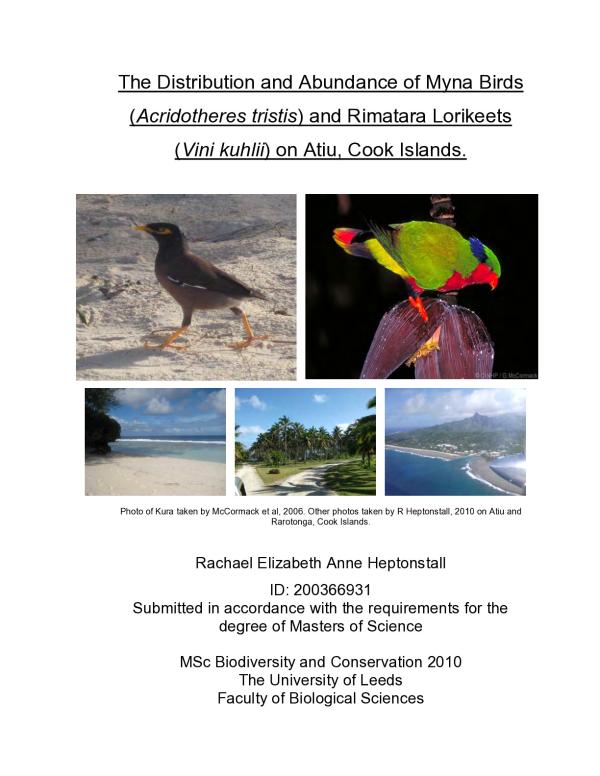Location
SPREP LIBRARY
Publisher
The University of Leeds
Publication Year:
2010
Publication Place
UNKNOWN
Physical Description:
52p. : ill. (col.) ; 29cm.
Call Number
[EL]
Relevant Countries
Cook Islands
Material Type
Language
English
Record ID:
247
Legacy PEIN ID:
80538
General Notes
Online only
Available online
Subject Heading(s)
Myna birds - Invasive species - Abundance - Cook Islands
Introduced animal - Alien species - Cook Islands - Oceania
Protected areas
Protected areas - Oceania
Protected areas - Management
Reserves
Reserves - Oceania - Pacific
Cook Islands
Invasive Species
Reserves - Cook Islands
Abstract
The Common Myna Acridotheres tristis was originally introduced to the island of Atiu, Cook Islands, in 1915 to control the Coconut stick insect Graeffea crouanii but it has since become a pest itself. The Rimatara lorikeet Vini Kuhlii or Kura was reintroduced, after disappearing from the Southern Cook Islands almost 200 years ago, to Atiu on 24th April 2007 from Rimatara, French Polynesia to create a reserve population due to there being only approximately 1000 birds left on Rimatara. Due to observations of mynas reportedly harassing and attacking adult and juvenile Kura at the nest, an eradication programme was introduced by Gerald McCormack, Director of the Cook Island Natural Heritage Trust (CINHT), in May 2009 to reduce the population size of myna birds to give the Kura a couple of peaceful nesting seasons to help establish a stable population on Atiu. A study by J. Mitchell of the University of Leeds in May/June 2009 estimated a starting count of approximately 6000 myna birds prior to the eradication programme. That survey was followed up in May 2010 using two strategies, the transect method and roost counts. Analysis of transect method counts, using the Distance software, estimate there are approximately 3128 mynas on Atiu. Roost counts were at variance with that figure and estimated only 1280 myna birds. The roost counts estimate of 1280 may be the most accurate because all mynas would be in the winter roosts for heat conservation from May to July alleviating the concern that females and young would be nesting away from the roosts during counts, whereas transect counts may involve recounting the same birds numerous times; a problem minimized by repeating transect counts twice daily and using different transects to cover as much of the expected habitat as possible. Only a limited survey of the population of Kura was possible during this visit to Atiu since almost all available time and logistics were focused on myna surveys. An estimate of the Kura population suggests there are approximately 100 birds, which suggests that since the 2007 introduction the Kura population is thriving on Atiu. However, comparisons with the exponential growth rate model of 184 birds suggest this difference could be due to myna bird harassment despite culling. A more comprehensive survey is recommended perhaps using similar strategies to determine whether the myna has any deleterious effect on the Kura. In July 2010 a new myna bounty was introduced and is proving successful as a further 383 myna birds were culled by the end of July. The Atiu Island Council may decide on complete eradication of the myna to give the Kura full advantage of living on Atiu in the absence of the competitive myna bird.
Location
SPREP LIBRARY
Publisher
The University of Leeds
Publication Year:
2010
Publication Place
UNKNOWN
Physical Description:
52p. : ill. (col.) ; 29cm.
Call Number
[EL]
Relevant Countries
Cook Islands
Material Type
Language
English
Record ID:
247
Legacy PEIN ID:
80538
General Notes
Online only
Record Created: 14-Nov-2016
Record Modified: 18-Feb-2022

